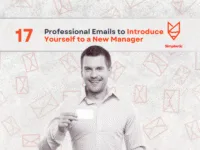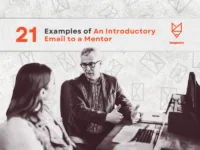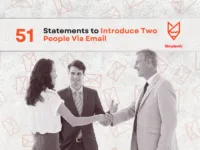Self-Introduction Email to A Client | 15 Example Email Templates |Creating genuine connections is essential in today’s competitive landscape, and introductions play a pivotal role in that process. They act as the initial handshake that can lead to lasting relationships.
The Power of First Impressions
A well-crafted introduction can create a favorable first impression, setting the stage for fruitful interactions. Personal anecdotes can illustrate this point vividly. For instance, consider John, a freelancer who landed a significant project by simply introducing himself at a local networking event. His articulate self-introduction not only captured attention but also demonstrated his experience.
Strategies for Effective Introductions
- Stay Authentic: Be true to who you are when introducing yourself.
- Be Relevant: Tailor your introduction to resonate with your audience.
- Follow Up: Don’t stop at introductions; maintaining contact is vital.
In essence, the art of introductions is a valuable skill that can pave the way for promising professional relationships.
Crafting an Engaging Self-Introduction Email to A Client
Once you’ve established the importance of introductions, the next step is crafting an engaging self-introduction email that resonates with the recipient.
Personalization and Customization
Personalization is key in making your email stand out. Tailor each self-introduction to the individual or organization by integrating specific details. For instance, mention a recent project they accomplished, and how it aligns with your expertise.
- Use Names: Always address recipients by their names.
- Reference Common Interests: If you share mutual connections, mention them briefly.
Conciseness and Clarity
While being thorough is important, less is often more. Aim for clarity and brevity to keep recipients engaged. A busy professional often appreciates emails that respect their time.
- Stick to the Point: Avoid long-winded explanations.
- Bullet Points Can Help: When listing skills or qualifications, bullet points make it easy to read.
Crafting a clear, engaging self-introduction email that reflects personalization ensures a strong first step in building connections.
Components of a Successful Self-Introduction Email to a Client
Having covered the initial steps of crafting your email, it’s time to delve into its core components for maximum impact.
Subject Line that Stands Out
A catchy subject line is your first impression, and it needs to grab attention immediately. Consider using a question or a bold statement related to your offering. For example, “Unlocking New Opportunities in Marketing” can pique curiosity.
Introduction of Yourself and Your Company
Next, provide a succinct yet informative introduction of who you are and what your company does. Highlight relevant experience and what sets you apart. For instance, “I’m Jane Doe, a marketing strategist with over five years of experience in digital campaigns.”
Clear Value Proposition
Your email must convey a clear value proposition. What can you offer that other professionals cannot? Outline the benefits of collaboration, such as “reducing marketing costs by 20%.”
Call to Action
Finally, end with a strong call to action. Encourage the recipient to respond or schedule a brief call. Something like, “Can we schedule a quick chat to explore how we can work together?” ensures the conversation continues.
These components together create a self-introduction email that captures interest and encourages engagement.
Tips for an Effective Self-Introduction Email to a Client
With a solid structure in place, it’s essential to focus on the nuances that elevate your self-introduction email. Here are some critical tips to keep in mind.
Establishing Rapport
Building a connection starts with establishing rapport. Use a warm tone and, if possible, mention shared interests or experiences. For instance, referencing a mutual friend’s recent success can create a sense of familiarity.
- Use Humor: A light-hearted joke can make your email more relatable, as long as it fits the context.
Showcasing Expertise
Demonstrating your expertise isn’t just about listing qualifications. Share a brief success story or a challenge you’ve overcome. This transforms you from just another email into a relatable professional.
- Be Specific: Instead of saying “I’m good at marketing,” say “I helped a startup increase its traffic by 150% in six months.”
Avoiding Common Mistakes
Finally, be mindful of common pitfalls. Avoid jargon that might confuse the reader and proofread your email to eliminate typos.
- Keep it Professional: While being personable is important, remember to maintain a level of professionalism throughout.
By incorporating these tips, your self-introduction email will not only inform but also leave a lasting impression.
Enhancing Engagement and Response Rates
Next let’s dive into strategies to enhance engagement and boost response rates for your self-introduction emails.
A/B Testing Subject Lines
A/B testing your subject lines is a proven method to see what resonates best with your audience. Try creating two variants of a subject line—one more straightforward and one with a touch of curiosity.
- Example A: “Exploring Opportunities Together”
- Example B: “How We Increased Client Engagement by 50%”
By tracking which subject line garners more opens and clicks, you can fine-tune your approach for future communications.
Analyzing Performance Metrics
Once your emails are sent, the next step is to analyze performance metrics. Key indicators to examine include open rates, click-through rates (CTR), and response rates.
- Open Rate: Shows how enticing your subject line was.
- CTR: Indicates how engaging the email content is.
By regularly reviewing these metrics, you can adjust your strategies to continually enhance engagement. This analytical approach helps ensure your emails not only reach inboxes but also inspire action.
Personalization for Self-Introduction Emails to Clients
When aiming to make a lasting impression during a self-introduction, personalization is critical. Tailoring your approach can significantly influence how your message is received.
Tailoring Content to Different Segments
Not all clients are the same, so adapting your content to different segments is key. For instance, if you’re reaching out to startups versus established businesses, your language and examples will differ.
- For Startups: Emphasize innovation and growth potential.
- For Established Businesses: Highlight reliability and proven successes.
By customizing your content, you demonstrate a deeper understanding of your audience’s unique needs, making your email more compelling.
Leveraging Personal Connections
Utilizing personal connections can also enhance the warmth and relatability of your self-introduction. If you both know a mutual contact, mention them to build credibility. For example, “I was referred to you by [Mutual Contact’s Name], who spoke highly of your work in [specific area].”
This kind of personalization not only grabs attention but also paves the way for more meaningful conversations.
Examples of Self-Introduction Emails to Clients
Armed with the tips for composing an effective self-introduction, it’s time to explore practical examples and templates that you can utilize.
Sample Template for New Client Introduction
Dear [Client’s Name],
I hope this message finds you well! My name is [Your Name], and I’m a [Your Role] at [Your Company]. We specialize in [brief overview of services offered].
I recently came across your project on [specific detail about their work], and I believe there’s an exciting opportunity for us to collaborate. Let’s discuss how we can help achieve your goals. Would you be available for a brief call next week?
Best regards, [Your Name] [Your Contact Information]
Follow-Up Email Examples
Following up is crucial for maintaining engagement. If you haven’t heard back, consider a friendly nudge:
Subject: Just Checking In
Hi [Client’s Name],
I wanted to follow up on my previous email about a potential partnership. I’m genuinely excited about the possibility of working together!
Do you have any availability for a quick chat? Looking forward to your response!
Best, [Your Name]
15 Self-Introduction Emails to Clients
Below are 15 self-introduction email templates tailored to different scenarios that emphasize personalization, clarity, and a strong call to action.
1. General Self-Introduction to a New Client
Subject: Excited to Work with You – [Your Name] from [Your Company]
Dear [Client’s Name],
I hope this email finds you well. My name is [Your Name], and I’m the [Your Role] at [Your Company]. I’ll be your main point of contact for [specific service or project], and I’m excited to collaborate with you.
With [X years] of experience in [specific field], I’ve helped clients like [specific example or achievement]. I’m confident that my expertise in [specific skill] will help us achieve [specific goal].
I’d love to schedule a quick call to discuss your needs and how we can work together. Please let me know a convenient time for you. Looking forward to connecting!
Best regards,
[Your Full Name]
[Your Contact Information]
2. Self-Introduction After Winning a New Client
Subject: Looking Forward to Our Partnership – [Your Name]
Dear [Client’s Name],
I’m thrilled to welcome you to [Your Company]! My name is [Your Name], and I’ll be your dedicated [Your Role] for [specific service or project].
I’ve reviewed your goals, and I’m excited to help you achieve [specific outcome]. With my experience in [specific skill], I’m confident we can deliver exceptional results.Let’s schedule a kickoff meeting to discuss next steps. Please let me know your availability.
Thank you for choosing [Your Company]. I look forward to working together!
Best regards,
[Your Full Name]
[Your Contact Information]
3. Self-Introduction to a Potential Client
Subject: Unlocking New Opportunities for [Client’s Company]
Dear [Client’s Name],
I hope this email finds you well. My name is [Your Name], and I’m the [Your Role] at [Your Company]. I came across [Client’s Company] and was impressed by your work in [specific area].
At [Your Company], we specialize in [specific service], and I believe we can help you achieve [specific goal]. For example, we recently helped [similar client] increase [specific metric] by [specific percentage].
Would you be open to a brief call to explore how we can work together?
Looking forward to your response!
Best regards,
[Your Full Name]
[Your Contact Information]
4. Self-Introduction to a Client After a Referral
Subject: [Mutual Contact] Suggested We Connect – [Your Name]
Dear [Client’s Name],
I hope you’re doing well. [Mutual Contact] recently mentioned your work at [Client’s Company] and suggested we connect. My name is [Your Name], and I’m the [Your Role] at [Your Company].
We specialize in [specific service], and I believe we can help you with [specific goal]. For instance, we recently helped [similar client] achieve [specific result].
Would you be open to a quick chat to discuss how we can collaborate?
Thank you, and I look forward to hearing from you!
Best regards,
[Your Full Name]
[Your Contact Information]
5. Self-Introduction to a Client After a Project Win
Subject: Excited to Collaborate on [Project Name] – [Your Name]
Dear [Client’s Name],
I hope this email finds you well. My name is [Your Name], and I’ll be leading the [Your Role] for [Project Name] at [Your Company].
I’m excited to work with you and your team to achieve [specific goal]. With my experience in [specific skill], I’m confident we can deliver outstanding results.
Let’s schedule a kickoff meeting to discuss next steps. Please let me know your availability.
Looking forward to our collaboration!
Best regards,
[Your Full Name]
[Your Contact Information]
6. Self-Introduction to a Client After a Conference
Subject: Great Meeting You at [Conference Name] – [Your Name]
Dear [Client’s Name],
It was a pleasure meeting you at [Conference Name] last week. I really enjoyed our conversation about [specific topic], and I’m excited about the potential for collaboration.
As we discussed, I’d love to explore how we can work together on [specific project or idea]. Would you be open to a follow-up call or meeting?
Thank you again for your time, and I look forward to staying in touch.
Best regards,
[Your Full Name]
[Your Contact Information]
7. Self-Introduction to a Client After a Promotion
Subject: Excited to Work with You – [Your Name], New [Your Role]
Dear [Client’s Name],
I hope this email finds you well. I’m excited to share that I’ve recently been promoted to [Your New Role] at [Your Company]. In this new position, I’ll be focusing on [specific responsibilities].
I’m looking forward to working more closely with you and your team to achieve [specific goal]. Please don’t hesitate to reach out if there’s anything I can assist with.
Thank you, and I look forward to our continued collaboration!
Best regards,
[Your Full Name]
[Your Contact Information]
8. Self-Introduction to a Client After a Company Change
Subject: Excited to Connect – [Your Name], Now at [New Company]
Dear [Client’s Name],
I hope you’re doing well. I wanted to let you know that I’ve recently joined [New Company] as the [Your Role]. While I’ll miss working with [Previous Company], I’m excited about this new chapter and the opportunities it brings.
At [New Company], we specialize in [specific service], and I believe we can help you achieve [specific goal]. Would you be open to a quick chat to discuss how we can collaborate?
Thank you, and I look forward to reconnecting!
Best regards,
[Your Full Name]
[Your Contact Information]
9. Self-Introduction to a Client After a Long Gap
Subject: Reconnecting – [Your Name] from [Your Company]
Dear [Client’s Name],
I hope this email finds you well. It’s been a while since we last connected, and I wanted to reach out to reintroduce myself. My name is [Your Name], and I’m the [Your Role] at [Your Company].
Since we last worked together, I’ve [briefly mention a relevant achievement or change]. I’d love to reconnect and explore how we can collaborate again.
Would you be open to a quick call or meeting?
Looking forward to hearing from you!
Best regards,
[Your Full Name]
[Your Contact Information]
10. Self-Introduction to a Client After a Referral from a Colleague
Subject: [Colleague’s Name] Suggested We Connect – [Your Name]
Dear [Client’s Name],
I hope you’re doing well. [Colleague’s Name] recently mentioned your work at [Client’s Company] and suggested we connect. My name is [Your Name], and I’m the [Your Role] at [Your Company].
We specialize in [specific service], and I believe we can help you with [specific goal]. For instance, we recently helped [similar client] achieve [specific result].
Would you be open to a quick chat to discuss how we can collaborate?
Thank you, and I look forward to hearing from you!
Best regards,
[Your Full Name]
[Your Contact Information]
11. Introduction to a Client After a Successful Project
Subject: Excited to Continue Our Collaboration – [Your Name]
Dear [Client’s Name],
I hope this email finds you well. I wanted to take a moment to thank you for the opportunity to work with you on [Project Name]. It was a pleasure collaborating with your team, and I’m proud of what we achieved together.
As we look ahead, I’d love to explore how we can continue working together on [specific goal]. Would you be open to a quick call to discuss next steps?
Thank you again, and I look forward to our continued partnership!
Best regards,
[Your Full Name]
[Your Contact Information]
12. Self-Introduction to a Client After a Company Rebrand
Subject: Excited to Reintroduce Ourselves – [Your Name] from [Your Company]
Dear [Client’s Name],
I hope you’re doing well. I wanted to reach out and reintroduce myself as [Your Company] has recently undergone a rebrand. My name is [Your Name], and I’m the [Your Role] at [Your Company].
We’re excited about this new chapter and the opportunities it brings. I’d love to reconnect and explore how we can collaborate on [specific goal].
Would you be open to a quick call or meeting?
Looking forward to hearing from you!
Best regards,
[Your Full Name]
[Your Contact Information]
13. Self-Introduction to a Client After a Industry Event
Subject: Great Meeting You at [Event Name] – [Your Name]
Dear [Client’s Name],
It was a pleasure meeting you at [Event Name] last week. I really enjoyed our conversation about [specific topic], and I’m excited about the potential for collaboration.
As we discussed, I’d love to explore how we can work together on [specific project or idea]. Would you be open to a follow-up call or meeting?
Thank you again for your time, and I look forward to staying in touch.
Best regards,
[Your Full Name]
[Your Contact Information]
14. Self-Introduction to a Client After a New Service Launch
Subject: Excited to Share Our New Service – [Your Name]
Dear [Client’s Name],
I hope this email finds you well. My name is [Your Name], and I’m the [Your Role] at [Your Company]. I’m excited to share that we’ve recently launched [New Service], which I believe could greatly benefit [Client’s Company].
With my experience in [specific skill], I’m confident we can help you achieve [specific goal]. Would you be open to a quick call to discuss how we can collaborate?
Looking forward to your response!
Best regards,
[Your Full Name]
[Your Contact Information]
15. Self-Introduction to a Client After a Industry Award
Subject: Excited to Connect – [Your Name], [Your Company]
Dear [Client’s Name],
I hope you’re doing well. I wanted to reach out and share some exciting news—[Your Company] recently won [Industry Award] for [specific achievement].
As the [Your Role] at [Your Company], I’m proud of what we’ve accomplished and would love to explore how we can help [Client’s Company] achieve similar success.
Would you be open to a quick call to discuss potential collaboration?
Thank you, and I look forward to hearing from you!
Best regards,
[Your Full Name]
[Your Contact Information]
A well-crafted self-introduction email to a client is a powerful tool for building relationships and opening doors to collaboration. By personalizing your message, keeping it concise, and including a clear call to action, you can make a strong first impression and set the stage for a successful partnership.
Use the templates above as inspiration, and tailor them to your specific situation. With these strategies, you’ll be well-equipped to connect with clients and grow your professional network.




